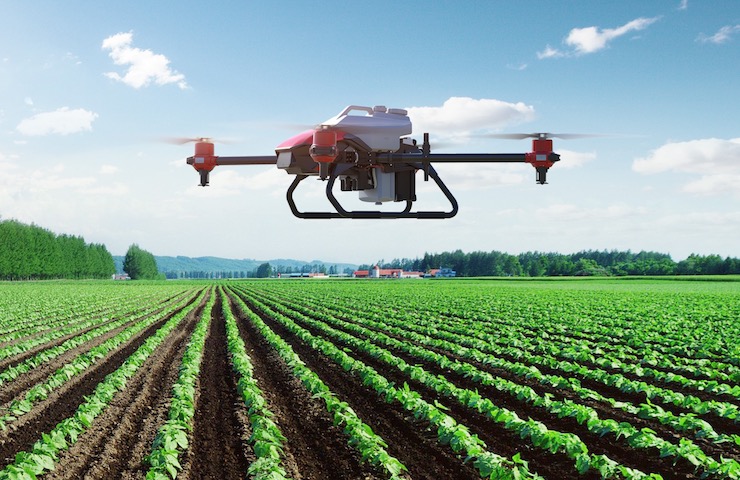XAG, China’s Largest Agricultural Drone Company, Using Drones to Spray Pesticides & Plant Seeds

© XAG
In 2007, Peng Bin and some trusted friends founded XAIRCRAFT with the goal of designing consumer drones. They spent some time looking into how drone applications could be used in a variety of industries but still hadn’t found their niche. Peng and his team took a trip to a rural rice farm to explore agricultural possibilities. Once at the farm they saw the difficult conditions under which aging farm workers had to strap heavy packs of pesticides onto their backs and slowly treat crops. Only able to cover small areas at a time, the workers toiled daily to treat the farm. Peng knew that this job could be made easier and more efficient with the use of a drone. Peng officially changed the company’s name to XAG and they chose to focus on agricultural drones.
By 2016, with the release of the P series agricultural drones, XAG had become one of China’s largest agricultural drone companies. The P series drones are built to withstand winds and water to be able to safely and quickly spray fields with pesticides. The drones can be simply hosed down after use to wash away any chemical residue. They are also able to fly autonomously. Detailed maps of an area to be treated are uploaded to the drone, then with a push of a button, it will fly the determined course and avoid any obstacles. With a customized spray nozzle, the drone applies chemicals in an environmentally safe manner while still thoroughly treating plants below.
XAG had proven to be leaders in agricultural drones, designing drones and software to allow for precision farming. But they realized there were still areas of farming that could be improved to give farmers productive fields. As more and more began to leave rural areas for better opportunities in the cities, XAG saw that farmers needed a way to increase planting productivity to make up for the missing workforce. XAG began working on a way to use drones to actually plant seeds in record time.
In 2019, XAG introduced the JetSeed Granule Spreading System that connects to the latest P series drones. The system uses a principle that was published by Daniel Bernoulli in 1738. Bernoulli’s principle revolves around fluid dynamics stating that if a fluid’s speed increases, it’s pressure decreases. This means that the change in speed needs to be matched by a change in pressure. As explained on XAG’s website, “Harnessing the Bernoulli principle, the 8 Electronic Ducted Fans (EDF) generate high-speed, focused airflows at up to 18 m/s. This creates a pressure difference that induces granules from feeder, whilst the granules, fueled by the accelerated airflows, are rapidly and precisely dispensed to the target area without being affected by environmental winds. Also, the spread width can be easily adjusted by tuning the air velocity or changing the jet nozzles.” The seeds are dispensed through a turnstile device that prevents the JetSeed from clogging or over spraying in any one spot. This results in a drone that can autonomously fly over a field and instantly plant the exact amount of seeds needed for optimal harvests.
A few months ago XAG demonstrated just how efficient the JetSeed attached to a drone could be. The demonstration took place at China’s Happy Farm in the Guangdong province, an agricultural park, and a testing site. The drone system was pitted against two experienced farmers to compare the planting of 5 kilograms of rice seed. Walking slowly through a flooded rice patty, the two farmers were able to plant their seeds over 1,200 square meters in about 25 minutes. Stocked with the same amount of seeds, the drone was sent to a different plot of land of equal size. Within 2 minutes the JetSeed drone system had successfully planted what took two humans a laborious 25 minutes.
According to XAG, the JetSeed drone system could accurately cover 50,000 square meters of land per hour with little to no seed waste. This same amount of coverage would require a farmer to employ 50-60 workers. In a time when China is seeing a rapid decline in farm workers due to people looking for work in cities, aging out, or under quarantine due to COVID-19, JetSeed could possibly save China’s rice production. Another benefit of the JetSeed system is that it can be used to plant at nighttime as well. At night, when temperatures are cooler and winds are calmer, planting is much easier. But it nighttime planting is not something that can be done by humans walking through rice paddies. Using the drones at night time means that not only can these optimal conditions be used, but farmers will have access to more planting hours per day to keep up with the demands to feed a world entering a food shortage crisis.
In the past, there has been much concern about the possibility of machines and drones taking jobs away from people. For the most part, drones have been used to assist people in their jobs. In fact, drones have led to an increase in job opportunities across almost every industry in which they are applied. True, the JetSeed is a device that will replace the need for human field workers. But in this case, there aren’t enough workers to get the job done in the first place, demanding an alternative means of planting. JetSeed is not yet commercially available as XAG explains, “Before officially entering each market, XAG’s products will be field-tested for not less than 3 farming seasons locally, and be commercialized after access allowance granted and complied with local regulations.” For now, they will continue testing it out at Happy Farm to ensure that it is perfectly positioned for use by farmers throughout the world.
|